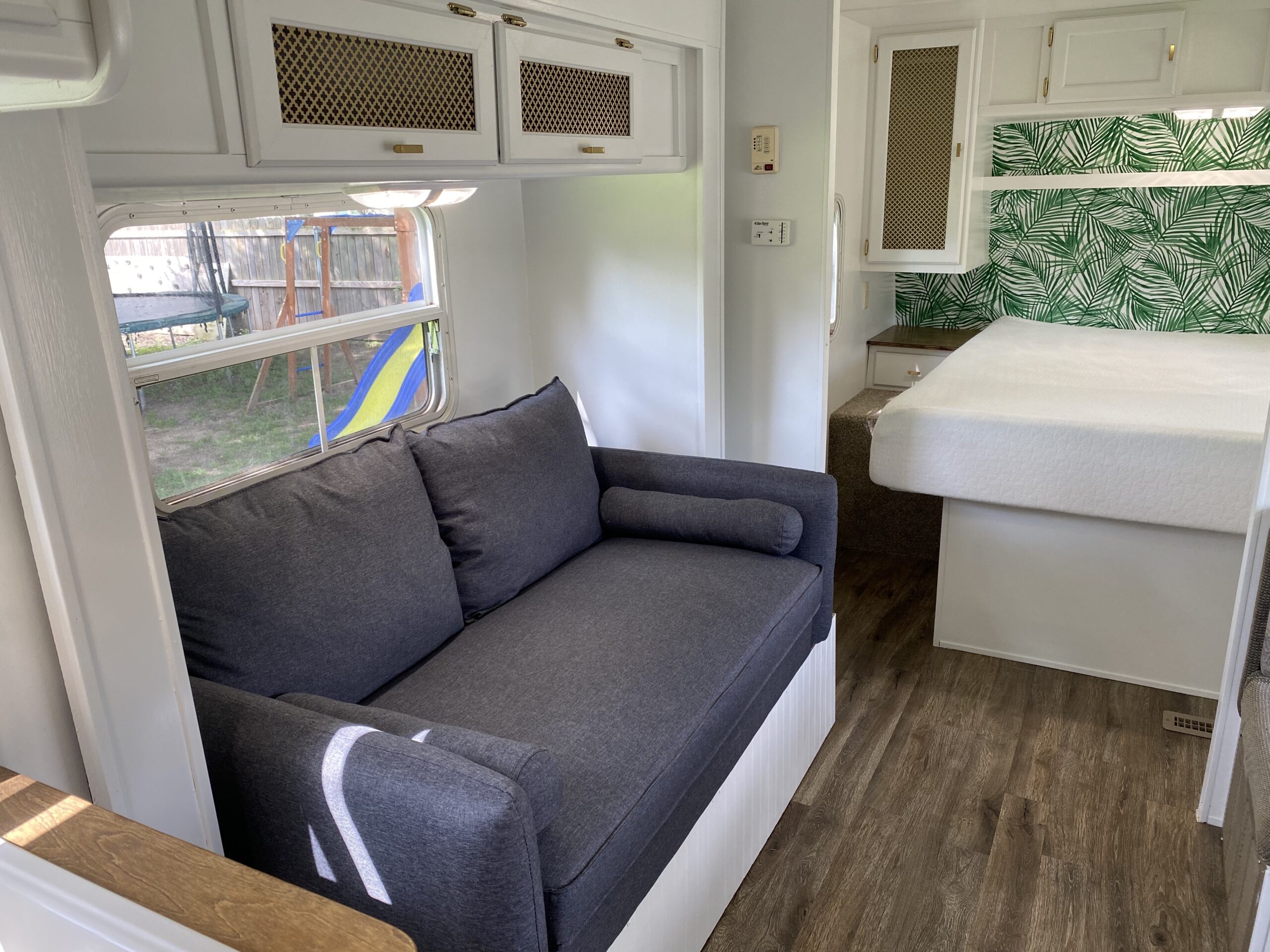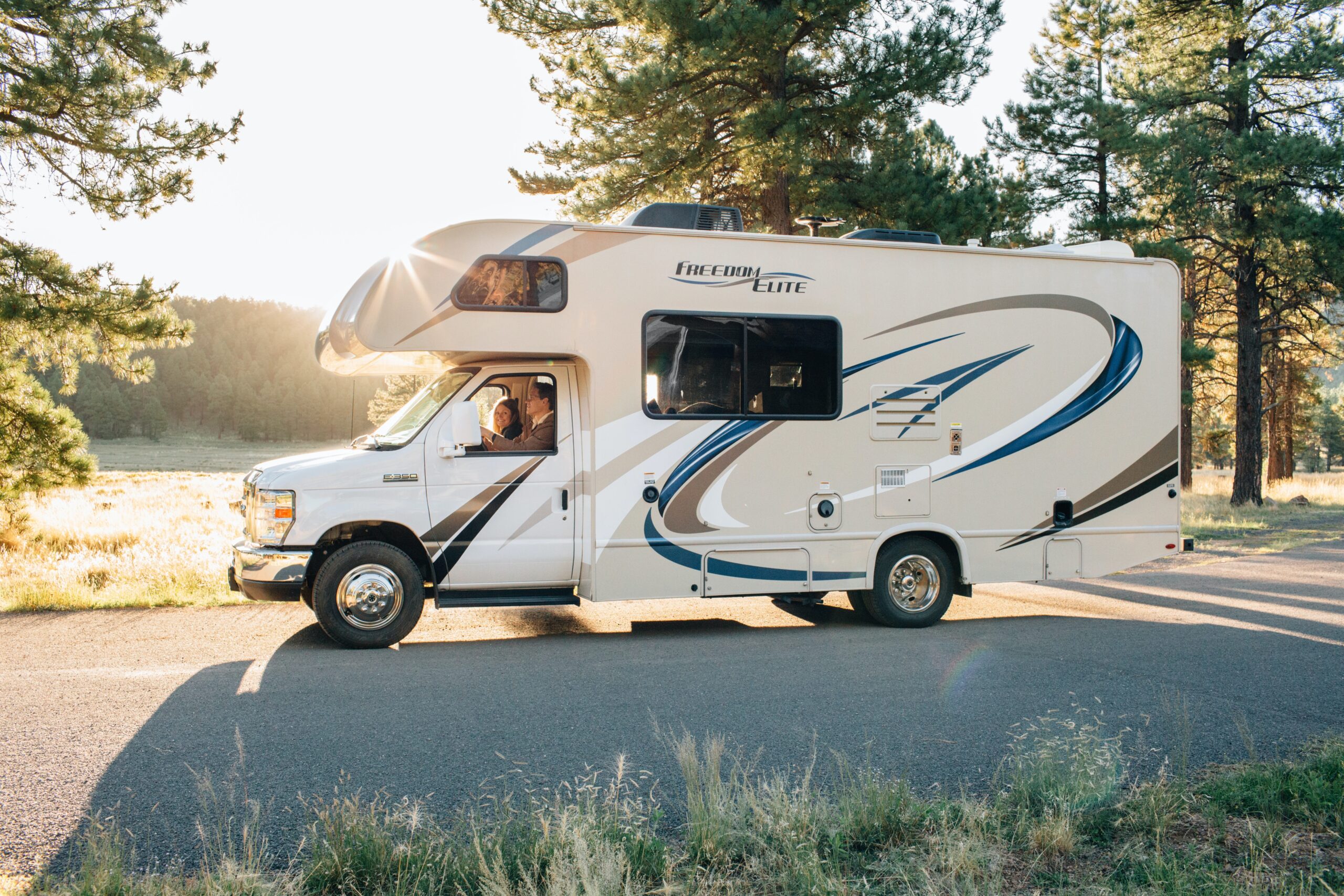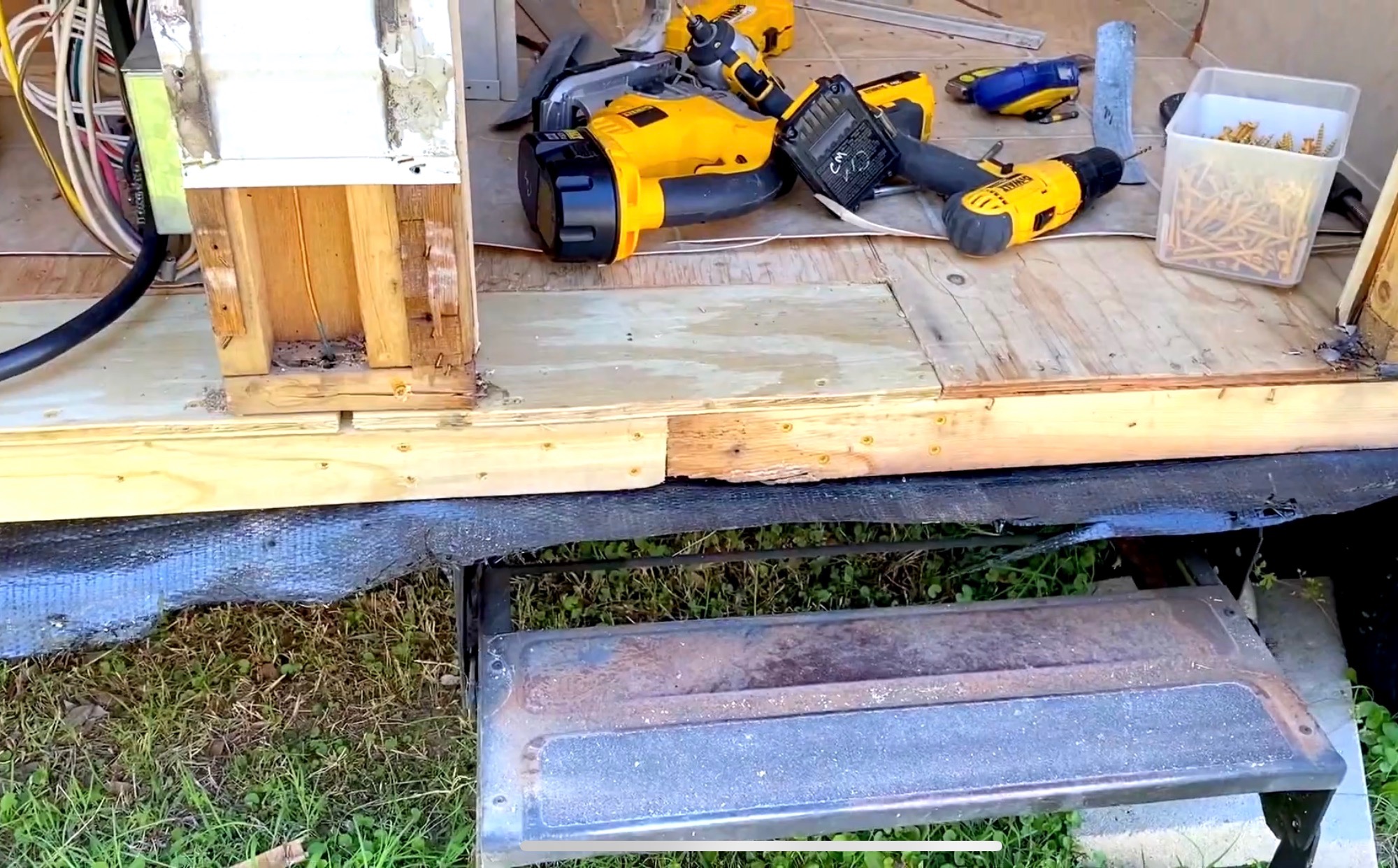However, the tint has many benefits beyond aesthetics and can make it easier and more comfortable to drive your vehicle.
But can you use window tint on an RV?
You can tint RV windows, but you must adhere to the laws of the state where you registered your vehicle. There are restrictions on the amount of light transmittance. Window tint is a good option for RV windows because it increases privacy, reflects UV light and heat, and strengthens the glass.
In this article, we cover how window tint works and the benefits that it can bring to your recreational vehicle.
We also cover the legality of window tint so you can comply with your state’s rules.
Lastly, we discuss options for DIY window tint and professional services.
How Does Window Tint Work?
Window tint is a layer of film that you place over the windows of your vehicle.
It acts to darken the glass, which protects the passengers from light and obscures their faces from view.
Many vehicles come with a degree of tint built into the glass.
However, the process of adding the tinted film is known as aftermarket tint.
You can install it yourself or employ a professional to add the tint.
Percentages of Tint
Different varieties of window tint carry different percentages of tint.
These percentages determine how dark the tint is and usually vary from 10% to 90%.
While it may seem contradictory, lower tint percentages allow less light into the vehicle.
The different levels of tint create different effects:
- Zero Tint: This is the bare window without tint. The glass is completely transparent, and so has maximum visibility but no protection from light.
- 5% Tint: The window is completely opaque, and you cannot see inside. The government prohibits the use of this tint on most vehicles.
- 20% Tint: The glass is opaque, but you can see through the glass from the outside if you are standing close enough.
- 35% Tint: There is clear visibility with a darkened appearance that also protects from UV light.
- 50% Tint: This is a very light tint that does not have visible darkness on the glass. However, it does help block sunlight and reduces glare and heat.
What Is Visible Light Transmittance?
Visible light transmittance (VLT) is sometimes called visible light transmission.
It refers to the amount of light that can pass through the glass of your RV windows.
For example, if you have a tint with a VLT of 35%, 35% of the light is passing through.
This means that the tint is stopping 65% of the light from passing through the window.
However, many modern vehicles have tint built into the original windows.
Therefore, any tint added on top of this will need to take that original tint into account.
You can measure the tint level of your RV with a tool like the Enforcer II Tint Meter.
No products found.
You can then choose your tint and calculate what the final tint will be.
You can multiply the visible light transmittance by the percentage of window tint.
For example, if you have windows with an existing VLT of 80% and you apply a 35% film, together, this will allow 28% of the light to pass through.
What Is Visible Light Reflection?
Visible light reflection (VLR) is the amount of light that bounces off the surface of the glass.
This level of reflection increases with darker tints. The tinted glass absorbs some of the light and reflects some of it.
You can measure visible light reflection if you know the shading coefficient of your glass.
This requires knowing how much heat is passing through the tinted glass compared to completely transparent glass.
You can then divide the VLT by the shading coefficient.
Because this requires several mathematical equations to calculate, it could be better to ask a window tinting professional for your vehicle’s level of VLR.
Many of the vehicle regulations for window tinting specify the level of minimum light transmittance.
However, some specify the permissible level of visible light reflection, so it’s important to check which one is applicable for your RV.
What Are the Pros and Cons of Tinting RV Windows?
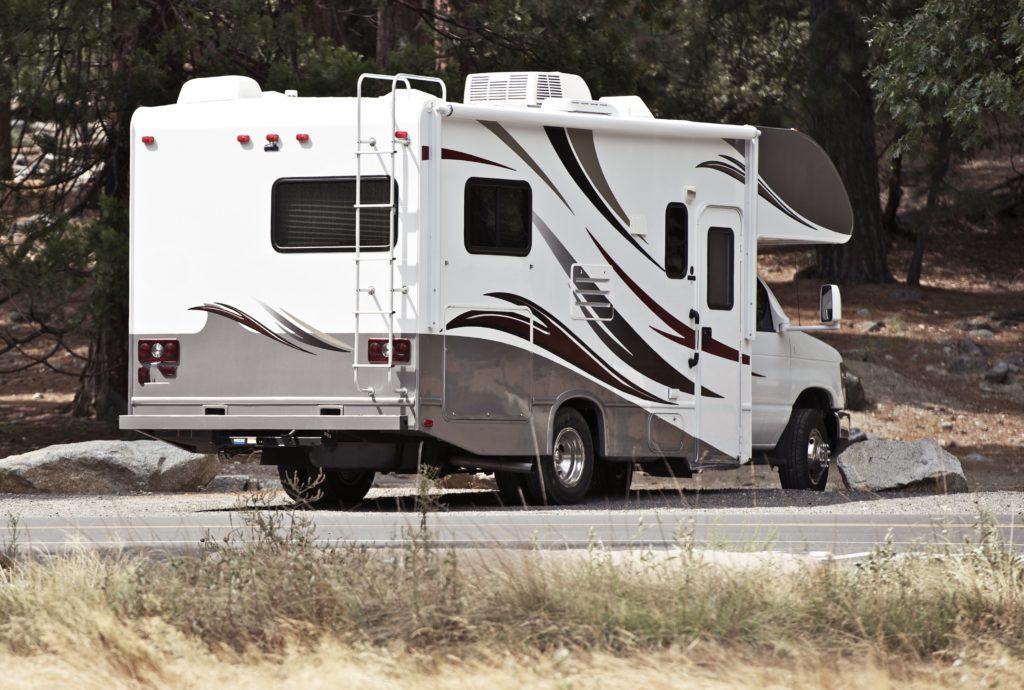
There are multiple advantages to tinting your RV windows:
- Increased privacy
- Reflection of UV light
- Reflection of heat
- Increased strength of the glass
There are no real disadvantages other than the extra cost involved.
Increased Privacy
One of the main aesthetic advantages of window tint is that it blocks people on the outside from being able to see inside the vehicle.
This is a huge advantage, especially if you are living in your RV for long periods.
It functions like your house, so being able to get away from prying eyes is essential.
You can also use curtains to increase privacy, but these can’t be used while driving if you need the windows for visibility.
Tinted glass allows you to take it one step further to make your mobile home more private and comfortable.
Reflection of UV Light
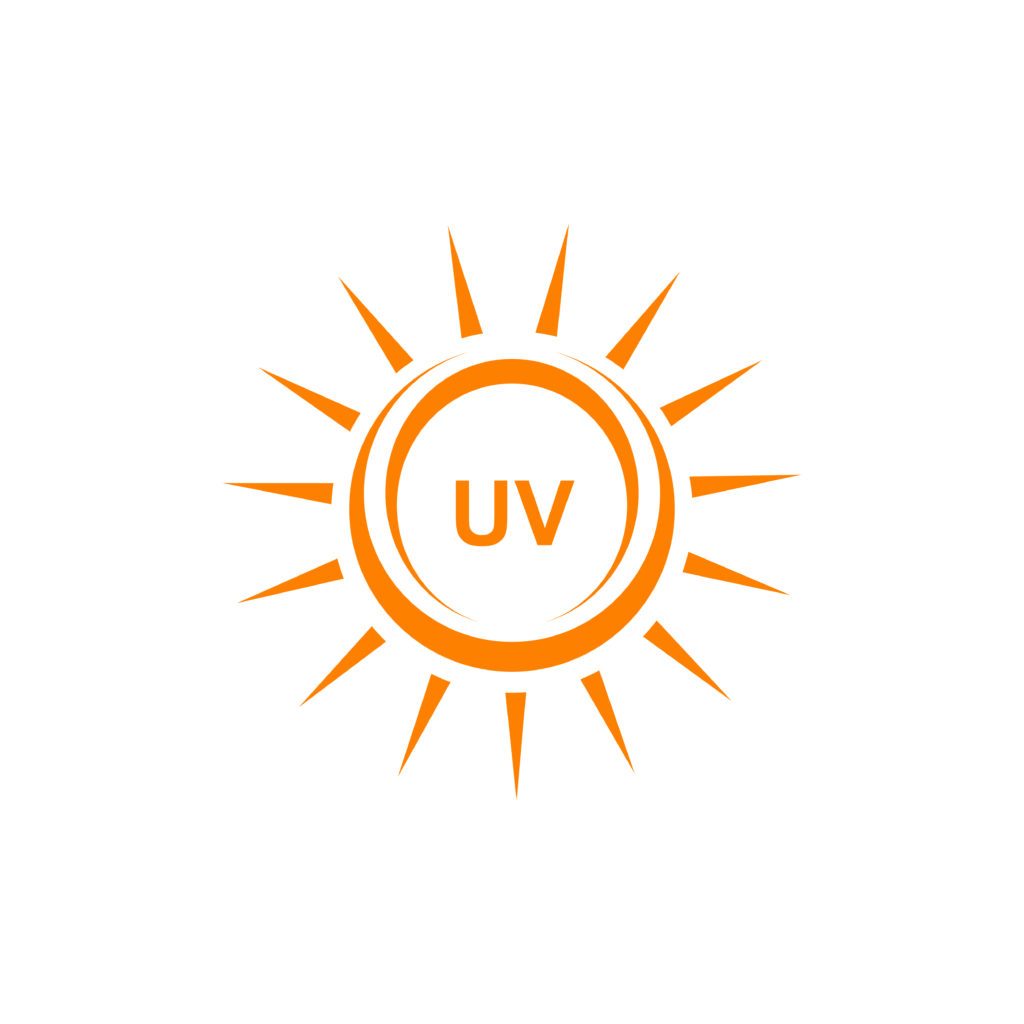
Window tint reflects UV light off the surface of the glass.
This is beneficial because high and prolonged exposure to UV light can increase your chances of developing skin cancer.
UV light has two different wavelengths: UVA and UVB. These wavelengths age and burn the skin, respectively, by damaging the cells of the skin.
This ultraviolet radiation alters the DNA of skin cells, which can mutate them and cause cancers to grow.
Common cancers caused by exposure to UV light include:
The side windows and windscreen in your RV can expose you to these harmful UV rays. The glass generally prevents UVB light from entering the vehicle, but not always UVA light.
Tempered glass, a common material for vehicle windows, can allow up to 79% of UVA light to get through.
Window tint can reduce the amount of UV light penetration by up to 99%.
Therefore, window tint can provide effective protection against UV light. The darker the tint, the more effectively it protects against UV.
This reflection of light is also helpful for reducing glare. Bright sunlight can be a hazard while driving because it gets in the way of the driver’s vision.
While not as effective as sunglasses, window tint can reduce some of this danger.
Temperature Control

Vehicles heat quickly when exposed to the sun. Window tint helps to keep your RV cool.
The tint itself is made of multiple layers, which absorb the heat of the sunlight. This prevents it from entering your vehicle and heating the interior.
Tints with higher VLR levels prevent higher levels of light and hence heat from entering.
A 2012 study found that window tint could reduce the temperature of a vehicle’s interior by up to 8℃ (46.4℉).
This study used a light tint of just 65-85%, so thicker tints have the possibility of reducing temperature even more.
Regulating temperature in your RV is important for several reasons:
- It helps you feel more comfortable
- It reduces the risk of dehydration and heatstroke
- It reduces damage to the interior of your RV
This is particularly helpful in summer when the risk of overheating is much higher. It also means that you won’t need to use the air conditioner as much.
This will save on fuel usage and hence cost, making window tint a great economic investment.
Stronger Glass
Some varieties of window tint increase the strength of your RV windows and make them less likely to shatter.
This kind of window tint is designed so to keep its shape even if it cracks.
This prevents the glass from breaking all over, which could injure you or make a huge mess.
This can protect you in the case of a car accident or break-in.
Is Tint Legal on RV Windows?
Before you decide to tint your RV windows, it’s important to check if tinting is legal.
If so, you also need to know to what extent you can tint your RV windows and where.
There are several considerations with RV window tinting:
- How much of the windshield can be tinted
- How much of the rear windows or side windows can be tinted
- Whether a licensed professional tinting company must install the tint
There are no specific window tint laws for RVs. However, states and countries specify tint laws for other vehicles like passenger cars, minivans, SUVs, and more.
It’s safe to assume that these same restrictions apply to recreational vehicles.
Where Is RV Window Tint Legal?
Tint regulations vary by state and country. We put together the regulations for the United States as a starting point.
At a minimum, vehicles need to comply with the Federal Motor Safety Standard 205, which requires that at least 70% of visible light can get through the windows used by the driver to see.
| State | Windshield | Rear windows | Side windows |
| Alabama | Top 6 inches | 32% light transmittance | 32% light transmittance |
| Alaska | Top 5 inches | 40% light transmittance | 70% light transmittance |
| Arizona | N/A | 35% luminous reflection | 35% luminous reflection |
| Arkansas | Top 5 inches | 10% light transmittance | 25% light transmittance |
| California | Upper part | Permitted with mirrors | Permitted for side rear |
| Colorado | 70% light transmittance | 27% light transmittance | 27% light transmittance |
| Columbia | 70% light transmittance | 70% light transmittance | 70% light transmittance |
| Connecticut | Top 29 inches | 32% light transmittance | 32% light transmittance |
| Delaware | N/A | N/A | N/A |
| Florida | N/A | 15% light transmittance | 28% light transmittance |
| Georgia | Prohibited | 32% light transmittance | 32% light transmittance |
| Hawaii | Top edge | N/A | N/A |
| Idaho | Top 6 inches | 35% light transmittance | 20% light transmittance |
| Illinois | Top 6 inches | Permitted with mirrors | Prohibited |
| Indiana | 30% light transmittance | 30% light transmittance | 30% light transmittance |
| Iowa | 70% transparency | 70% transparency | 70% transparency |
| Kansas | Above AS1 line | 35% light transmittance | 35% light transmittance |
| Kentucky | Top strip | Permitted with mirrors | 25-35% solar reflectance |
| Louisiana | Top 5 inches | Tint not permitted | Tint not permitted |
| Maine | Top 5 inches | 35% light transmittance | 35% light transmittance |
| Massachusetts | Top 6% | 35% light transmittance | 35% light transmittance |
| Maryland | Top 5 inches | 35% light transmittance | 35% light transmittance |
| Michigan | Top 4 inches | Permitted | Permitted |
| Minnesota | Prohibited | 50% light transmittance | 50% light transmittance |
| Mississippi | Prohibited | 28% light transmittance | 28% light transmittance |
| Missouri | Upper section | 35% light transmittance | 35% light transmittance |
| Montana | Above AS-1 line | 35% light transmittance | 35% light transmittance |
| Nebraska | Above AS-1 line | 20% light transmittance | 35% light transmittance |
| Nevada | Above 29 inches | Permitted with mirrors | 35% light transmittance |
| New Hampshire | Top 6 inches | 35% light transmittance | Prohibited on front windows |
| New Jersey | Permitted for medical reasons | Permitted with mirrors | Permitted with mirrors |
| New Mexico | Top 5 inches | 20% light transmittance | 20% light transmittance |
| New York | Top 6 inches | 70% light transmittance | 70% light transmittance |
| North Carolina | Top 5 inches | 35% light transmittance | 35% light transmittance |
| North Dakota | 70% light transmittance | 50% light transmittance | 50% light transmittance |
| Ohio | N/A | N/A | N/A |
| Oklahoma | Top 5 inches | 25% light transmittance | 25% light transmittance |
| Oregon | Top 6 inches | 35% light transmittance | 35% light transmittance |
| Pennsylvania | Manufacturing standards | Manufacturing standards | Manufacturing standards |
| Puerto Rico | N/A | 35% light transmittance | 35% light transmittance |
| Rhode Island | Top 6 inches | 70% light transmittance | 70% light transmittance |
| South Carolina | Above AS-1 line | 27% light transmittance | 27% light transmittance |
| South Dakota | 35% light transmittance | 35% light transmittance | 35% light transmittance |
| Tennessee | 70% light transmittance | 35% light transmittance | 35% light transmittance |
| Texas | Top 5 inches | 35% light transmittance | 35% light transmittance |
| Utah | Top 4 inches | Permitted without limits | 43% light transmittance |
| Vermont | Permitted for medical reasons | Permitted for medical reasons | Permitted for medical reasons |
| Virginia | Uppermost section | 50% light transmittance | 50% light transmittance |
| Washington | Top 6 inches | 50% light transmittance | 24% light transmittance |
| West Virginia | N/A | 35% light transmittance | 35% light transmittance |
| Wisconsin | N/A | 35% light transmittance | 50% light transmittance |
| Wyoming | Above AS-1 line | 28% light transmittance | 28% light transmittance |
Laws are subject to change and you should keep up to date with any changes in the state where you registered your vehicle.
It might be helpful to print out the laws of your state in case you are questioned by law enforcement officers.
How to Tint RV Windows
Many states require a certificate that says any aftermarket window tint has been installed by a professional company. However, some only have restrictions on the amount of light that passes through.
If this is the case for your state and you want to install the window tint yourself, this can be an economical alternative to a professional installation. First, you will need to purchase your tint. We recommend the Lexen 2ply Premium Carbon Automotive Window 35% Tint Film.
No products found.
One of the main issues with a DIY window tint job is that you will need to cut your own window sections.
While some brands offer pre-cut sections, these are usually measured to smaller vehicles like sedans and hatchbacks.
RV windows vary greatly in size, so you will need to customize them for your particular vehicle. Here’s how:
- Remove any window screening and curtains to give yourself easy access to the glass.
- Use a clean cloth to clean the crevices around the windows and the glass of the windows.
- Measure all of your windows and mark the measurements on the window film. You might also like to make a stencil from paper.
- Use a razor blade to cut the window film. You might like to cut a little larger than your measurements and trim the excess after.
- Make an adhesive solution from one part of alcohol, two parts water, and two drops of baby shampoo.
- Use a squeegee and the adhesive solution to clean the inside of your window. If you prefer to buy a cleaning solution, avoid any brands that use ammonia or vinegar because they can interfere with adhesion.
- Put a small piece of tape on each side of the window film for your window and stick them together.
- Pull them apart slowly to remove the liner from the window film.
- Spray the window completely in the adhesive solution.
- Remove the liner and spray more adhesive solution onto the exposed window film.
- Put the wet side of the window film against the inside of the wet window.
- Use tape to secure in the correct position if needed.
- Push any excess solution out to the edges of the window with the squeegee.
- Use a razor and a card to crease the edge of the window film against the edges and cut off any excess.
- Use the card to remove any air bubbles or liquid from under the window film.
- Leave it to dry, and don’t wash the window film for at least a month.
This video walks you through the window tinting process in an RV:
Conclusion
In conclusion, you can tint your RV windows. Window tint is an advantage because it increases privacy, minimizes exposure to sunlight, reduces glare, and can even make your RV’s glass stronger.
You should check the local laws to see the minimum levels of visible light transmittance and maximum levels of visible light reflection.
It’s important that your window tint does not compromise the driver’s ability to drive safely and see the road.
You can get a professional installation or complete the job yourself, depending on the regulations of your state or country.
If you choose to do the job yourself, make sure that your chosen tint complies with the laws.
Window tinting has many practical uses beyond aesthetics, and we hope this guide has given you all the tools you need to get started.
Good luck!


